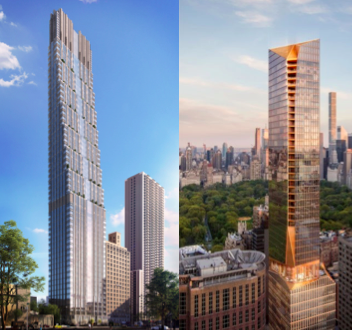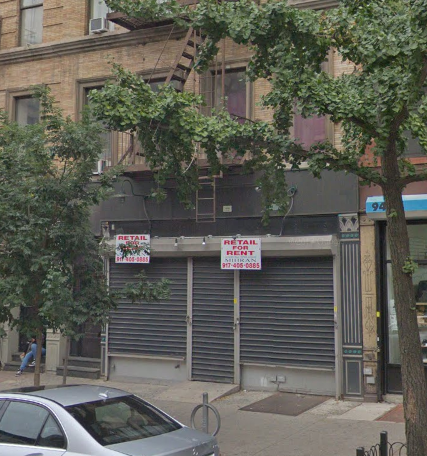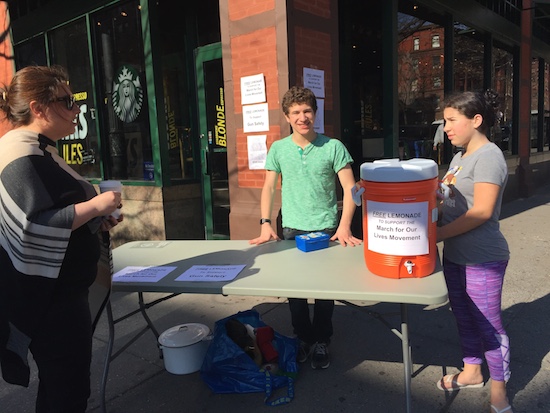
Renderings of 200 Amsterdam (left) and 50 West 66th Street (right).
On Wednesday, Community Board 7 will be tackling a subject that has some Upper West Siders stressed out — tall apartment towers.
A building planned for 200 Amsterdam Avenue (69th Street) is set to rise 668 feet, making it the tallest building in the neighborhood. But there’s another proposed building that could soon eclipse it — Extell Development is planning a potential 775-foot tower at 50 West 66th Street.
Critics consider those buildings to be out of scale with the neighborhood, and have been looking for ways to stop them. In the case of 200 Amsterdam, an initial zoning challenge failed but the project is now being challenged at the city’s Board of Standards and Appeals, with a hearing set for next month.
On Wednesday, the community’s board’s land use committee will discuss the towers in a public meeting scheduled to run for three hours, from 6:30 to 9:30 p.m., at Goddard Riverside, 593 Columbus Avenue at 88th Street.









And I’ll bet a good number of these critics are living in buildings that were “out of scale” with the neighborhood when they were built. Hypo-critics!
Building proposed at 50 W 66th street will make a cross town nightmare for several years no matter how tall they build it
I won’t be able to attend the meeting (I have a job and kids), but would like to voice my support for tall buildings, especially in areas like Lincoln Center which already have tall building and aren’t “brownstone UWS”.
Prices are skyrocketing because of the enormous barriers to entry to real estate development. One of those barriers is the endless steam of red tape strung up by people trying to calcify their neighborhood and stand in the way of basically any and all development.
New York needs many more apartments and that means building higher. I would be great if all of New York was populated by cute brownstones punctuated by a couple iconic skyscrapers, but that doesn’t meet the demand of the many people who want to live in this great city. I support tall buildings (especially tall buildings with many apartments) to meet this need.
Tall buildings come with challenges. We may been to build more infrastructure and schools to support them, but I believe we can meet those challenges. I’m a pro-change optimist who believes in the dynamism of New York and the positive power of change.
The problem is not the height of the towers, it is the fact that developers are not required to upgrade or expand existing infrastructure to accommodate new residents. We should be requiring developers to expand subway entrances and pay fees or donate space within new buildings to expand schools. Instead we give them huge tax breaks. It’s not about the size of the buildings, it is the burden that they place on infrastructure that was built for a very different type of neighborhood. We should absolutely be building new apartments, as supply is constantly outstripped by demand, but we can’t let developers profit while the rest of us suffer the unbearable crowding that results.
That’s an excellent recipe for ensuring that nothing ever gets built again.
Do you have any idea how much taxpayer money the Board of Ed and the MTA waste? The BoE’s laughable “rubber room” is still very much in effect 9 years after the first story ran about it.
That’s where your ire should be directed.
In the case of these two proposed towers they are intended to be condos rather than rentals.
Developers get 421-A tax breaks for providing a certain number of “affordable” rental units in new rental buildings.
As these new buildings are not rentals they will not have any tax breaks.
However, I do agree that developers should be given incentives to help upgrade the neighborhood’s infrastructure. This way the entire community will benefit, not just a lucky few lottery winners who get cheap apartments.
That’s an old, cliched, and lame opinion. Infrastructure improvements should never be dependent on government’s ability to extort developers. Government’s responsibility is to make improvements without regard to how many developers it can induce to invest in the neighborhood with tax breaks. If NYC didn’t have arcane union rules that pad every construction project and job, there would be money for improvements. How many more constructions workers holding STOP/SLOW signs can we tolerate? Especially when they’re standing next to useless traffic enforcement officers at the same intersection.
“… repeating the myth that these ultra-tall high end buildings have any noticeablle effect on supply of affordable housing. ”
We need more housing period. I agree that tall towers with very few apartments do little to alleviate housing demand. I’d much prefer to see developments with high apartment density. My one hope is that the high end market will eventually become saturated and developers will focus on a more “modest” end market. That won’t happen until we allow a lot more building rather than fighting every development tooth and nail.
The problem as I see it is that NIMBYs aren’t advocating for higher density development. To the contrary they claim that higher density development will overtax infrastructure. They demand essentially NO DEVELOPMENT. That’s even worse than luxury towers. Taking marginal supply to 0 will only cause prices to go substantially higher.
So what’s the solution? I suggest relaxing building restrictions for new developments with high apartment density. Focus on building MORE APARTMENTS. I don’t care if that’s up down or sideways.
Bravo! You are so right! We have no supermarket and inadequate pharmacies. DR on 72nd is hopelessly inadequate and the cloSure of 2 of their better stores was a bad decision. Trader Joe’s is a crowded mess of tourists from recently renovated hotels and downtown/uptown visitors. Dirty streets and roaming belligerent homeless don’t help. A huge high rise cannot add anything but more crowds and chaos UNLESS they provide neighborhood amenities.Lowes is pointless. Huge spaces reserved for day care? Limited use. ThE 20th precinct-unresponsive and rude.We witnessed an incident Sat.2/17 at 1pm where a deranged man dropped his pantS anD peed in the Window of Sephora..When 911 finally Showed up-they were rude and blase and disinterested. Next time I WILL get their names. My point being–no one is in control and no one will keep the chaos down. Brought on by overcrowding in a decaying neighborhood. Who got paid off for thiS building permit? That’s the question.
These two buildings are masterpieces compared to the rest of the dreck in that area. Let ’em rise, already – there’s plenty of other things to worry about!
You want to condition development on the developers’ ability to provide new supermarkets and pharmacies? Why am I not surprised…this is the UWS where people can’t wait to be offended.
UWS4ever says:
“We should absolutely be building new apartments, as supply is constantly outstripped by demand, but we can’t let developers profit while the rest of us suffer the unbearable crowding that results.”
… repeating the myth that these ultra-tall high end buildings have any noticeablle effect on supply of affordable housing.
if i recall correctly, the 200 Amsterdam monstrosity has about 100 units, and those are all ultra high end. the effect of extra supply that will “trickle down” to even upper-middle-class units will be, for all basic purposes, zero.
Not everyone is as fortunate as you were, Bruce, to get an insider deal when they purchased their apartment.
Therefore, we need new construction.
Sherman says:
“Not everyone is as fortunate as you were, Bruce, to get an insider deal when they purchased their apartment.”
This is a nasty personal attack, which seems to show some jealousy on your part. You personally attack rent stabilized tenants and now you personally attack an owner of a modest condo, all while hiding behind your curtain of anonymity. You certainly must be proud.
But this “insider price” charge is worth addressing, as there are some lessons there.
Our building was a large (240 unit) rent stabilized building for many decades. The prices were affordable and — guess what — the owners made money on it!
Then, circa 2005, the building was bought by a greedy, well-connected developer, Brack Capital — the same people who bought the Williams from the salvation army. they quickly started the condo development process, forcing out all the market rate tenants. They also used the renovation process to harass rent stabilized tenants and try to get them to move. This was covered in the NY Times.
We formed a tenants association and retained a lawyer in order to negotiate with Brack. I was one of the leaders of the association.
Through maintaining unity (it wasn’t easy), we were able to get a number of concessions and protections, the most important being a 10 year moratorium on Major Capital Improvement rent increases (MCIs) for those who wished to stay as rent stabilized tenants, and an insider’s discount for those who wished to buy.
it wasn’t perfect, but it was far better than what we would have gotten if we didn’t get organized and counter the greedy developer.
Have i benefited from the run-up in real estate prices on the UWS? Indeed i have, but not at the expense of my rent stabilized neighbors. And i would have been perfectly happy staying in the old affordable rent stabilized housing, pre-condo.
the only way to counter the endless attacks from the read estate industry on our living standards and housing costs is — get organized! the real estate barons and their shills want more and more and more…
reply to Sherman:
wow… you’re even a bigger jerk than I thought. and that’s pretty hard, because before that last posting, i thought you were a pretty big jerk.
but once again, to answer some factual points in your hate and anger-filled screed:
Sherman said:
“You took advantage of a crooked system by living for years in a rent-regulated apartment and paying a pittance in rent.”
there is nothing CROOKED about the rent stabilization system. the main CROOKED thing is that landlords often defy the laws to overcharge, etc.
And i paid far from a pittance in rent. in fact, i paid a pretty high price under rent stabilization.
Sherman said:
“When your building turned condo you got an insider deal and you were able to purchase your apartment for next to nothing.”
Once again, that is very far from the truth. it was not “next to nothing.” But i did make a smart investment. I guess you have a problem with that?
I’m sorry that you apparently are not happy with your own living situation. But maybe you should look elsewhere than rent stabilized tenants or individual condo owners for the source of your problems.
Hi Bruce
Let’s analyze your living arrangement.
You took advantage of a crooked system by living for years in a rent-regulated apartment and paying a pittance in rent.
When your building turned condo you got an insider deal and you were able to purchase your apartment for next to nothing.
I’m sure your “modest” apartment is today worth astronomically more than you purchased it for.
You now spend your time stalking me online and calling everyone else “greedy”.
You’re a hypocrite and the reason NYC has a housing affordability problem. You should reserve the “greedy” attacks for yourself.
The height of the towers is also an issue, in addition to the very real problems you mention. They make the neighborhood dark, casting long shadows, and are unwelcoming and oppressive. The upper west side has many brownstones and 2 story buildings. These colossal towers severely change the tone of the neighborhood.
In theory, the wealthy residents of these buildings should generate high tax revenues for the city. The building should generate property taxes as well. These funds should finance infrastructure expansion on an intelligent, top-down basis.
Demanding that developers do things like expand subway stations and build schools on an ad-hoc basis creates a complicated and unnecessary barrier to development. Building creates economic growth, the city should channel development based on that growth.
I agree on eliminating the tax breaks though which don’t make a much sense currently. I’d rather see development encouraged by the cutting of red tape and relaxing of onerous zoning restrictions (some of which is happening, but not nearly enough).
John, can you be more specific about the “onerous zoning restrictions” you mention?
The Upper West Side is 72nd Street to 110th Street.
Just FYI.
So, what’s 66th Street? Clinton/Hell’s Kitchen?
For us old timers ,,, Upper West Side still remains as the North side of 57 street to the South side of 110 street (river to Central Park). The “West Side” is historically referred to the boundary of 23 rd street (where 12th Ave begins) up to 110 street.
That area , just north of Columbus Circle, is commonly referred to as Lincoln Square.
It’s way to ritzy to be considered the UWS.
According to you anyway…
The UWS runs the length of the park FYI
I hear you but I guess I am just old school…really old school.
From Wikipedia:
“Traditionally the neighborhood ranged from the former village of Harsenville, centered on the old Bloomingdale Road (now Broadway) and 65th Street, west to the railroad yards along the Hudson, then north to 110th Street, where the ground rises to Morningside Heights. With the construction of Lincoln Center, its name, though perhaps not the reality, was stretched south to 58th Street. With the arrival of the corporate headquarters and expensive condos of the Time Warner Center at Columbus Circle, and the Riverside South apartment complex built by Donald Trump, the area from 58th Street to 65th Street is increasingly referred to as Lincoln Square by realtors who acknowledge a different tone and ambiance than that typically associated with the Upper West Side. This is a reversion to the neighborhood’s historical name.”
Oversized buildings and little or no moderate priced apts, infrastructure and parking for those who cant bicycle to wherever they are going.
Yes, I have heard that the mayor wants to wean people from cars yet how come our last mayor has a car drive him around the corner from his home to his foundation.
Why hold this meeting so far uptown when the towers are in the 60s? That’s right, I’m too lazy to travel twenty blocks!
About 10 years ago I made a stink about the change in Building codes, which would allow developers to replace moderately sized buildings into sky scrappers. No one cared about my predictions then (over population, lack of parking, and most of all , , , our infrastructure is incapable of handling it). Our subways are packed, water and electrical lines will require upgrading, and NO politician is winning a battle against these developers.
I’m tapped out on this fight. Good Luck people!
In sorting out facts, first, hooray for CB7’s keeping the forward momentum: In or by 2015, discussion of a moratorium on new extremely tall towers pending an update in developer regulations had “gone viral”; about 2 years ago CB7 invited concerned neighbors to a discussion of as-of-right development, if I recall accurately; the meeting was postponed till…now. Current architectural engineering permits taller than usual buildings on smaller than usual footprints, wherein lie infrastrucural woes as well as aesthetic ones.
Yet, along Broadway are several recent, late 20th century buildings that fit well in their beaux arts milieu (like The Montana and even Ariel East and Ariel West). Their is much convincing evidence that as far as developers are concerned De Blasio is a “pay-to-play” mayor. Last, an article I noticed this week (am trying to locate it now) seems to have been (trying to say) the Board of Standards and Appeals is now receptive to an update in regulations to keep up with new technology.
It sounds like I’m defending development, truth is, I’m in defense of preservation.
Isn’t Extell the corporation that built the two towers at Bway & 100th but wasn’t able to successfully dismantle the one-story supermarket on Bway & 100th without having the scaffolding collapse onto a baby carriage? (The child survived, because the carriage was better built than the scaffolding, but the nanny’s leg was broken, if I remember correctly.) Aren’t they also responsible for the collapsing crane on W. 57th St. while building another non-contextual tower? And they’re still allowed to keep building wherever and whenever?
I attended the public community board meeting before the 100th St. towers were built, but apparently it was a done deal without needing the board’s approval. The Extell team (the Execs, PR people and the two architects) was there to “meet their new neighbors.” But from the Q&A it was clear they had absolutely no knowledge of the neighborhood beyond having seen the block maps. [One questioner said she was a teacher at a preschool at Ansche Chesed, whose entrance was across the street from the planned loading dock of one of the buildings, and wondered what plans they had to ensure the children’s safety. The Team looked at each other blankly. Someone then asked, “Have any of you ever BEEN on the Upper West Side?” The head honcho said sure, he had an office there once. “Where?” “In the W. 60s.”
Living across the street I have to comment on the construction accident that occurred while Ariel West was being built. A backhow was clearing the demo ruble in the back of one of the small buildings that was taken down on the 99th street. It some point one of the wheels of the backhoe broke thru a void in the ground causing the backhow to tip over striking the scaffolding street shed. Everything was up to code and spec when the accident happened. The void was not list on ANY DOB plans for the site and so was unknown to the contractor. Its thought that it might have been a disused private septic tank, based on the age of the buildings that were there. But that is just one possibility for the unknown void.
Developers are not construction companies; they hire contractors to do the actual work. So impugning their reputation and integrity by referring to one workplace accident bu a sub-contractor is a hollow argument.
I support the increase in housing supply through the development of more and taller apartment buildings. It is sorely needed.
These comments are all fine and good, but I’m waiting breathlessly for Wendy’s Take
When it comes, can you translate it for the rest of us?
The new building designs are beautiful and excellent architecture. I think the height is great and nice to have some tall buildings on UWS.
I also agree with Paul RL’s comment:
“These two buildings are masterpieces compared to the rest of the dreck in that area.”
So many of the other buildings on UWS built in the 60’s and 70’s are so ugly that these buildings will bring some nice designs and make the surrounding area much better. Most of the new buildings that have been going up when the architecture has been good have improved the areas they were located in. As long as the builders don’t rent to Drug Stores and Banks on the ground floor and utilize great designs for the buildings I am all in favor of them.
Don’t know why people keep harping on about (chain) drug stores and banks; the ship of them expanding onto every block has sailed.
If anything look around; Duane Reade, Walgreens, CVS and others are closing stores in the city. Banks are either closing branches or shrinking them down to suit their push to get more customers doing most or all of their business online.
“Critics consider those buildings to be out of scale with the neighborhood, and have been looking for ways to stop them”
The only thing inevitable is more change. Its interesting to note that in the 1950’s when this was the 15th congressional district that was carved out for one of FDR’s sons on the UWS head and a handful of developers created what became Park West Village. At the time media and local self appointed community leaders said the same things about the height and scale of those building, At the time they went up that are was brownstones and 4 to 5 story tenements.